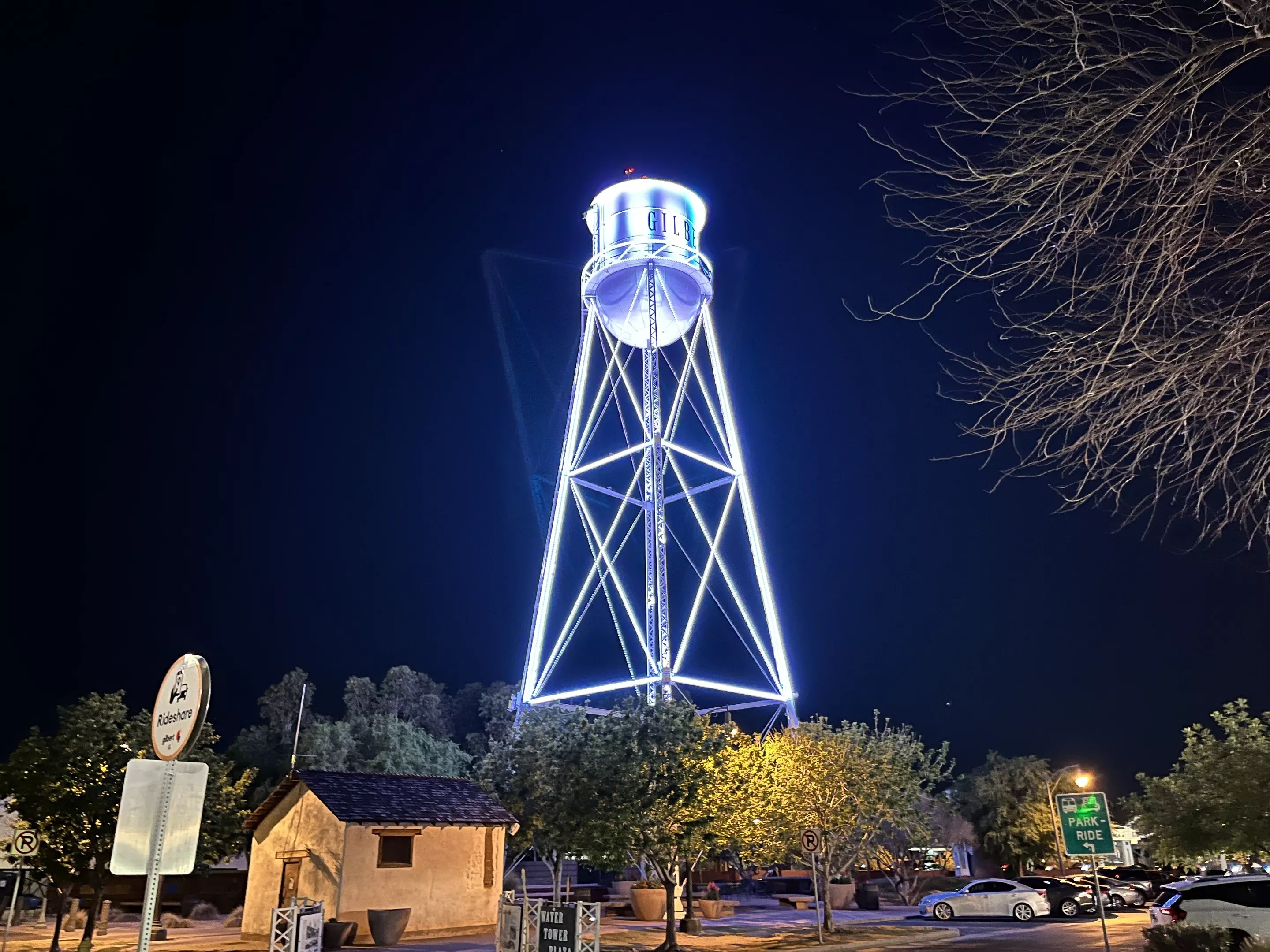
Georgann Yara

Audio By Carbonatix
A few yards from the main drag, two-dozen people queue above a descending staircase. A glowing red light affixed to the brick building is a beacon for those seeking the speakeasy beneath it.
Two blocks north, a much longer line featuring several bachelorette parties spools around a country bar spilling music into the street.
A short stroll northeast, 20- and 30-somethings pack an arcade bar, mixing booze and games. Busy sidewalks are filled with pedestrians ducking in and out of establishments along the way.
This Saturday scene is the norm in downtown Gilbert on weekend nights, even though it’s barely 9 p.m.
Over the last few years, this nook of the southeast Valley known for its family life, agricultural history and landmark water tower has emerged as a bar hotspot. In rideshare drivers’ circles, this .3 mile stretch of Gilbert Road bounded roughly by Hearne Way on the north and Cullumber Avenue on the south is known as “Mini Old Town.” In bouncer and bar security circles, it’s thought of as a more behaved and mature Mill Avenue.
Six or seven years ago, declaring any part of Gilbert as a party district would’ve been met with knee-slapping laughter. But today, downtown Gilbert, also known by its official name the Heritage District, has a drink-dance-cavort persona that’s no joke.
It serves a demographic that doesn’t want the drive, pricey ride-booking service or attitude they’ve experienced in Scottsdale or Tempe.
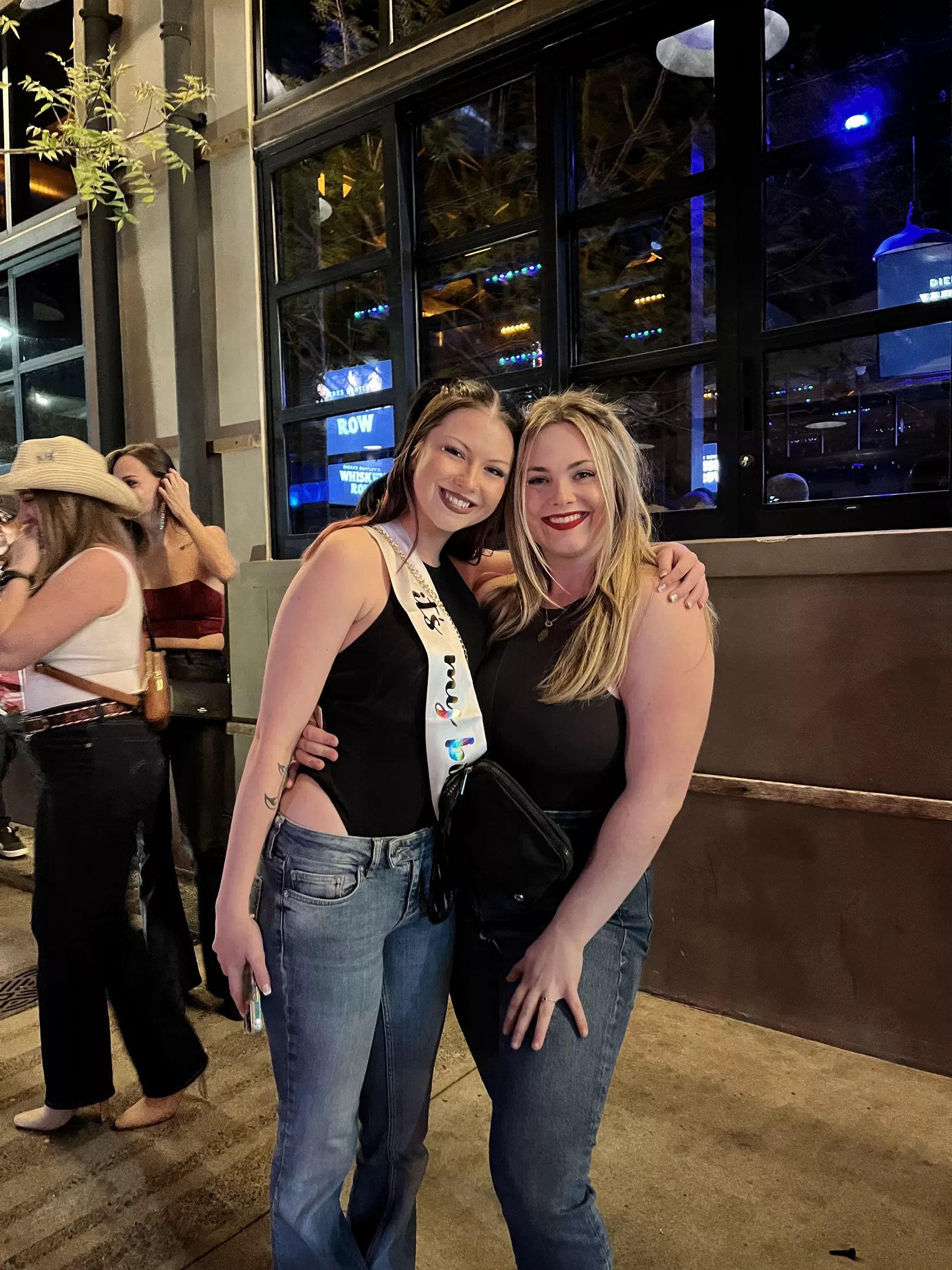
Alexie Malone, left, and Sophia Orthmer wait outside of Dierks Bentley’s Whiskey Row. The Gilbert residents hit downtown Gilbert to celebrate Malone’s 24th birthday.
Georgann Yara
Outside Dierks Bentley’s Whiskey Row, Alexie Malone sports a banner that reads “It’s My Birthday.” She and her bestie Sophia Orthmer are in a line of about 100 people waiting to get into the bar named after the country music star.
These Gilbert residents hit downtown every weekend, they say. O.H.S.O. Brewery and Distillery and The Porch are also favorites. They had dinner at Postino earlier. Hands down, the Heritage District is their nightlife spot of choice.
“You have to have a super specific aesthetic to get into clubs out in Old Town and here it’s a lot more chill,” Malone says. “Down here is easier, closer, less expensive and has a good vibe. You know you’re not going to have to deal with too much and it’s still going to be a good time, whereas Old Town can be a lot.”
Orthmer says she likes the inclusivity and lack of attitude.
“Mill is all 21-year-olds fresh out of college. Scottsdale is kind of like a showy crowd. Here, you can be any age and hang out with your friends. When you go into Whiskey, sometimes there’s grandmas boogie-ing down,” Orthmer says.
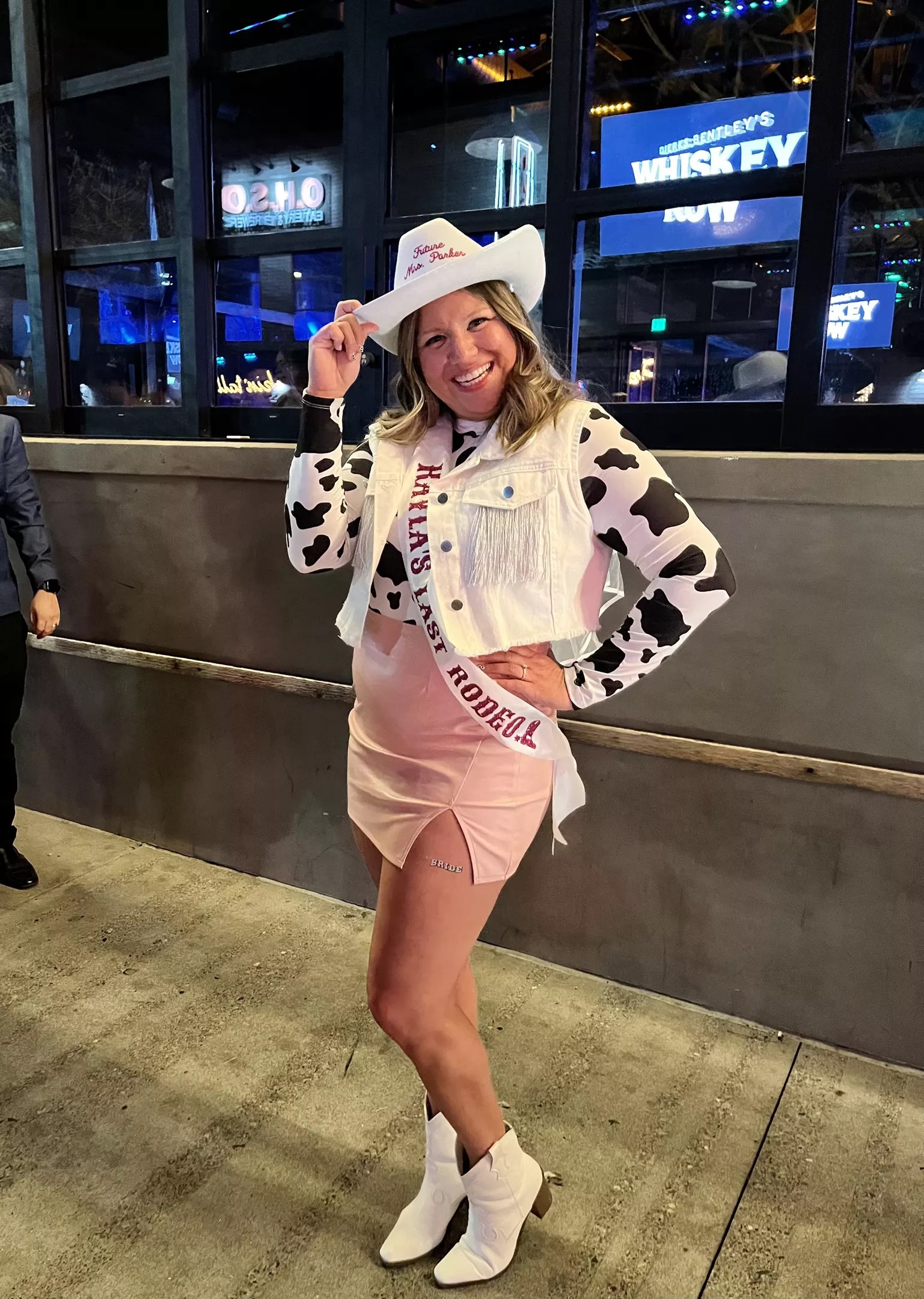
Surprise resident Kayla Murillo poses while in line to get into Dierks Bentley’s Whiskey Row. She and her bridal party ventured from the West Valley and rented an AirBnB near downtown Gilbert for her bachelorette party weekend.
Georgann Yara
Bachelorette Kayla Murillo was there with her bridal party of five. This was Murillo’s first venture to downtown Gilbert. Her love of country music and the reputation of Whiskey Row drew them out. She lives in Surprise and most of her crew live in the West Valley. They rented a nearby AirBnB for a mini-staycation.
“Old Town Scottsdale is too much so we wanted to come somewhere a bit more chill,” Murillo said.
Their opinion is pretty common among downtown regulars: the collection of more than 30 restaurants and bars offers something for a broader crowd.
“We definitely draw a different demographic that’s more reserved and not as rowdy,” says Jeffrey Mosser, who provides security at The White Rabbit Bar, a speakeasy known for its high-end whiskey selection and prohibition-era cocktails. “I think it’s up and coming because people want a different outlook on the nightlife. They come out here where it’s respectable and people are nice and still have a good time.”
Filling a sweet spot is apparently Gilbert’s jam. And somehow this sleepy, conservative, suburban town became home to a honky-tonking, bass-pumping, wine-sipping party district.
A dining and drinking hub
But it hasn’t always been this way. The White Rabbit general manager Joey Quatmann VI recalled moving to Gilbert 15 years ago.
“Back then, they rolled up the streets at 8 or 9 o’clock. There was nothing out here. Only a few bars,” he says.
When The White Rabbit opened in 2018, there was a learning curve for both his team and guests, many of whom were introduced to this level of craft cocktails at his bar.

Craft cocktails were not the norm in Gilbert when The White Rabbit first opened.
Tirion Morris
Quatmann credits Gilbert’s reputation as a safe city that’s conducive for family living as the reason for the population growth. However, in recent years, savvy business owners saw these few blocks transforming into an entertainment district and tapped into that revenue potential.
At 8:45 p.m., Mosser stood at the top of the stairs of The White Rabbit. By day, the Heritage Court building it calls home is home to offices and shops. At night, however, the buzz is below ground level. Through an ear comms system, co-workers inside notify Mosser when guests may head down. A password obtained through the bar’s website changes monthly and is required to enter.
Mosser estimates the speakeasy serves 300-500 people a night on Friday and Saturday, and 80-100 on the other days. The selection of sophisticated spirits and what their bartenders do with them draws mature generations as well as 21st birthdays, anniversaries, and pre-wedding celebrations.
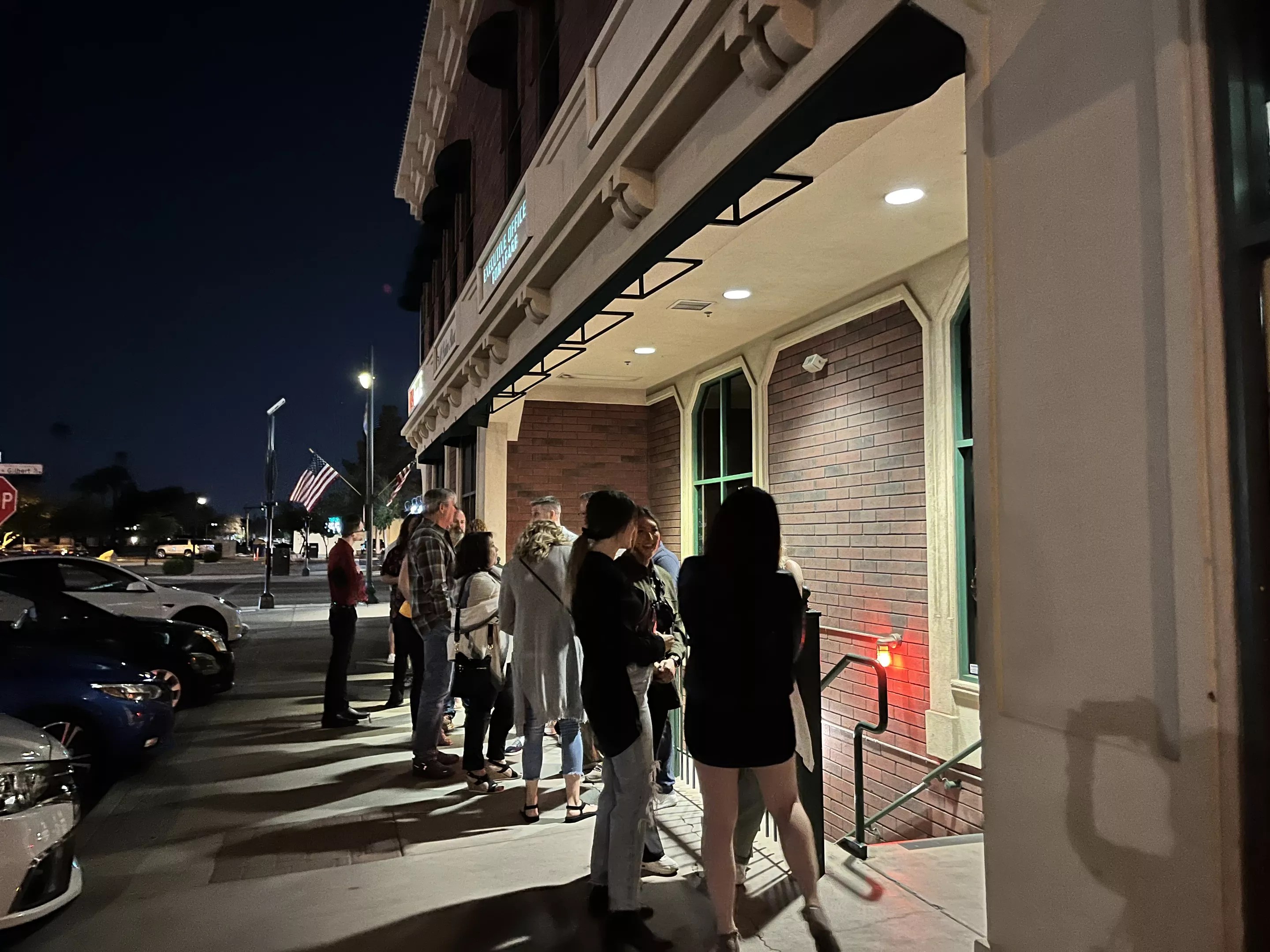
A line of customers waits for their turn to descend the stairs to The White Rabbit.
Georgann Yara
Around the corner, James Harrison and his wife emerged from a ride-hailing vehicle with friends. All are recent empty nesters. They made the 10-minute drive from their homes for a night out and were headed to The White Rabbit. Harrison had the month’s password, “Hush Havana,” pulled up on his phone.
Ever since their youngest left for college last summer, the Harrisons have hit downtown about once a month, they say. Sometimes they have dinner at Joe’s Real BBQ or Postino, check out a show at the Hale Centre Theatre or, like tonight, barhop.
“It’s nice to have a centralized place where we can do all of that and not have to drive too far or spend a lot on an Uber,” Harrison says.
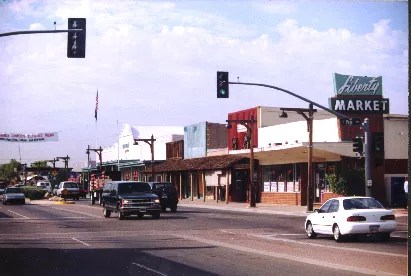
This photo of Liberty Market was taken in 2006.
The Town of Gilbert
Joe Johnston’s Outsized Impact
If there’s one person who understands the Gilbert lifestyle it’s Joe Johnston, whose family has been instrumental in shaping the town. The man behind Joe’s Farm Grill and Agritopia found success as an early downtown restaurateur, first with Joe’s Real BBQ and then Liberty Market.
Johnston moved to the East Valley city when he was 2. He grew up near downtown and recalled that, while not the hubbub of activity it is today, it was never a ghost town that needed reviving.
The inspiration for his barbecue restaurant came during the expansion of his former Coffee Plantation coffee house chain that brought him to Texas. Barbecue joints housed in old brick buildings there caught his eye. He returned to downtown Gilbert and saw the historic buildings through a new lens.
Pondering his next project, Johnston realized parallels between the coffee and barbecue businesses. When Joe’s Real BBQ opened in 1998, Gilbert’s population was 60,000, he says. The restaurant options weren’t plentiful.
“It was gangbusters since day one,” Johnston recalls.

Gilbert Road near Page Avenue in the 1940s. Today, the area is home to Joe’s Real BBQ, Postino and Liberty Market.
The Town of Gilbert
In 1943, Ben and Mae Ong purchased nearby Liberty Market and operated it as a grocery store. In 2006, when the store came up for sale, Johnston decided to keep it local rather than see it become a bland outpost of a big box. He and wife Cindy renovated the space and it evolved into the restaurant it is today.
Around this time, downtown started to bustle. The idea of a restaurant that served wine, beer and cocktails also picked up traction amid a sea of family-focused eateries.
“Liberty was more urban, but over time it did well. That got people noticing that maybe not just a family restaurant but more urban restaurants may do well,” Johnston says.
Across the street, however, it was a different story. That space experienced multiple unsuccessful establishments including Diamondbacks 2001 World Series hero Luis Gonzalez’ Gonzo’s, which folded after a year.
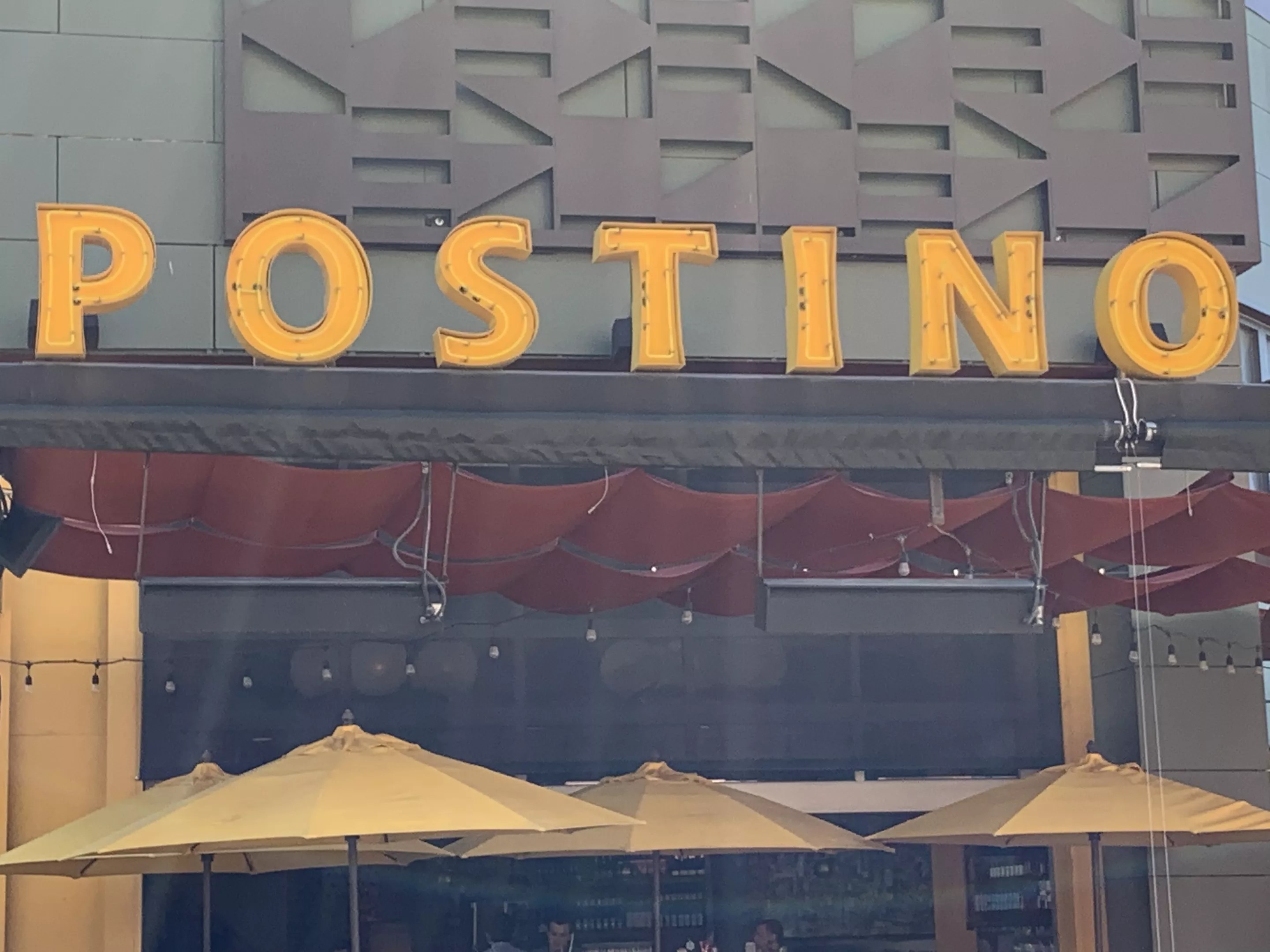
Postino is a popular destination within Gilbert’s Heritage District.
Rudri Bhatt Patel
The Postino Effect
That changed in 2012, when Postino opened. Lauren Bailey, co-founder of Upward Projects, the parent company behind Postino, says Johnston helped alleviate many doubts about expanding into a new area that wasn’t quite proven.
Any residual reservations were eliminated the day Postino opened. Bailey and co-founder Craig DeMarco underestimated how busy they’d be right off the bat and called in employees from other stores to help. Bailey was filling drink orders and DeMarco was washing dishes.
That pace inspired the opening of Upward Projects’ Joyride Taco House next door the following year.
“There were a lot of chains, but I think that area was so hungry for hallmark favorites to come out there. They had to drive so far for a place to hang,” Bailey says.
After Postino, high-profile establishments like O.H.S.O. Brewery and Distillery, The Porch, Whiskey Row and Sam Fox Restaurant Concepts’ Culinary Dropout and Zinburger followed. The proof was in the wine carafe.
“A Gilbert person can succeed in Gilbert. But when a Phoenix person comes in and succeeds in a more urban and alcohol-centric environment, people stand up and notice,” Johnston says.
An influx of high-paying healthcare, tech and other big industry jobs has created a community with income to spend. According to the 2021 Census, Gilbert has the second-highest median household income in the Valley at $105,733. It follows Paradise Valley’s $203,659, overtook Scottsdale’s $97,409 and is ahead of the $91,299 of nearby Chandler.
“Gilbert has always been underestimated,” Johnston says.
However, there is one aspect that was not. In fact, quite the opposite.
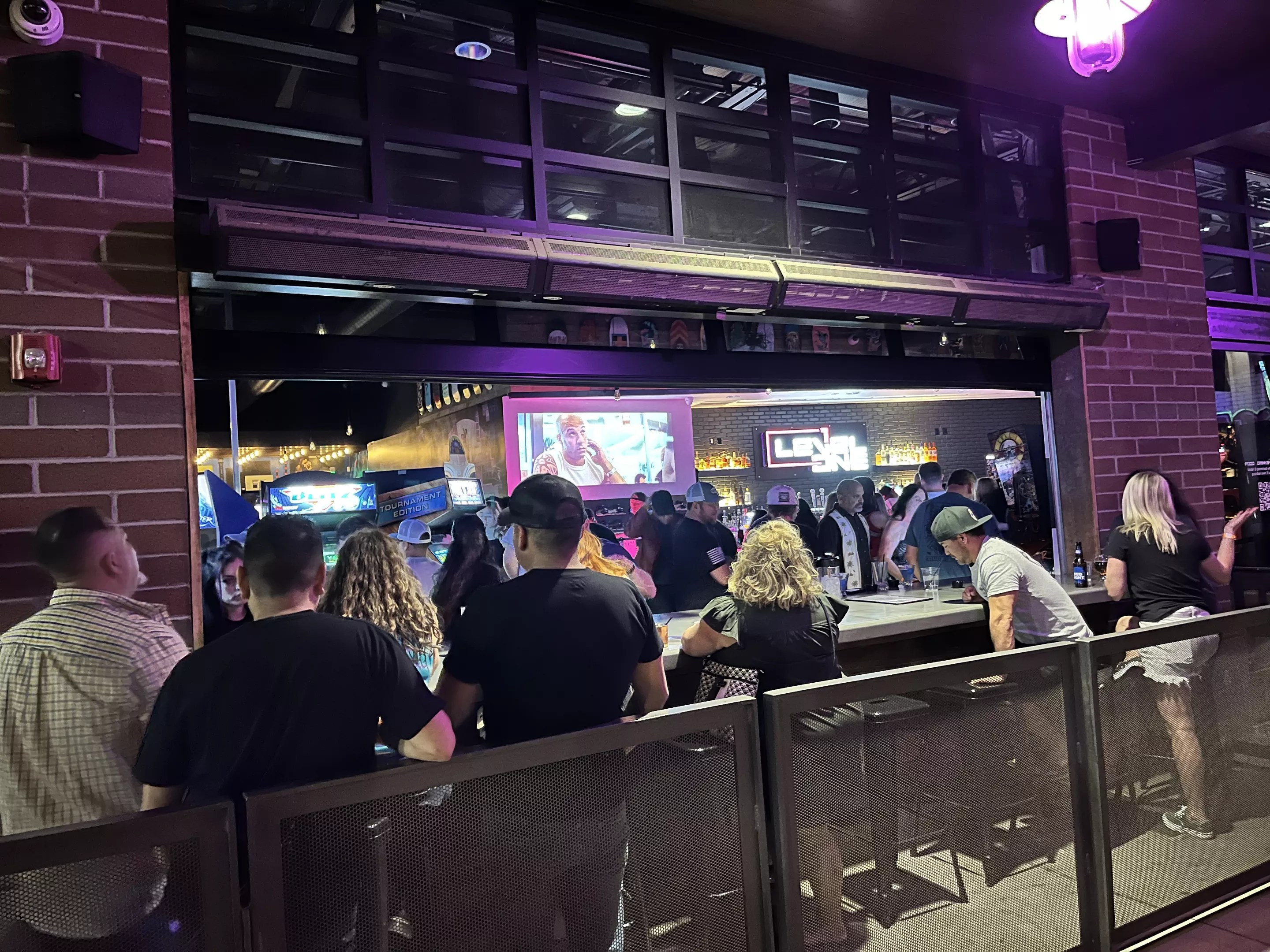
Level 1 Arcade Bar is a popular meeting spot for friends before they hit the rest of the Heritage District’s bars.
Georgann Yara
‘People don’t drink out there’
The public’s perception of Gilbert being a Mormon town is taken as fact. However, actual numbers are difficult to come by. The Census doesn’t track religion, and neither does the Town of Gilbert. The media specialist for the Metro Phoenix Area for the Church of Jesus Christ of Latter-day Saints said in a written statement that membership numbers are tracked by geographical boundaries that don’t line up with city boundaries so obtaining “even a semi-accurate number would be an onerous process.”
However, various reports estimate LDS membership to represent a percentage as low as 6.4 percent and as high as 13 percent of Gilbert’s population of more than 270,000, neither as large as perceived. Their involvement with school governing boards and government positions while often being people of influence makes their presence seem larger, Johnston explains.
Still, the notion that Gilbert is dominated by a faith that shuns alcohol provided understandable pause for restaurateurs whose revenue relies heavily on the sales of wine, beer and spirits.
“Everyone told us we are crazy for going out there, that people don’t drink out there,” Bailey says. “But Craig and I felt there are a lot of great customers living out there.”
Since it opened, Postino’s Gilbert location is consistently in the top three among Postino restaurants for wine sales, Bailey says.
“Annex and Gilbert are always neck and neck with each other,” Bailey says, referring to Postino’s location in downtown Tempe.
Downtown Gilbert stays packed until 2 a.m., when the bars close. At that time, a mass exodus occurs with patrons heading to parking garages or queuing at designated ride-hailing spots.
Gilbert Police Department’s public information officer Levi Leyba acknowledged that the Heritage District is likely safer than the other party districts.
A combination of police presence and proactive measures – such as a 25-mile-per-hour speed limit and a bike patrol unit that focuses specifically on downtown – helps ensure potentially dangerous behaviors are kept in check.
“Often, the people who do come down here are respectful to our laws. A majority of the time, people that are pulled over are outside of that area. We have strict enforcement and people are aware and adhere to it,” Leyba says.
When asked about DUI and other alcohol-related calls for service, Leyba says, “that can happen anywhere,” and that those calls often happen in areas around drinking establishments away from downtown.
Do unwanted behaviors fueled by a good-time vibe, liquid courage and crowds occur? Sure. But typically, officers respond to more tame calls, such as graffiti or making sure the public restrooms are safe.
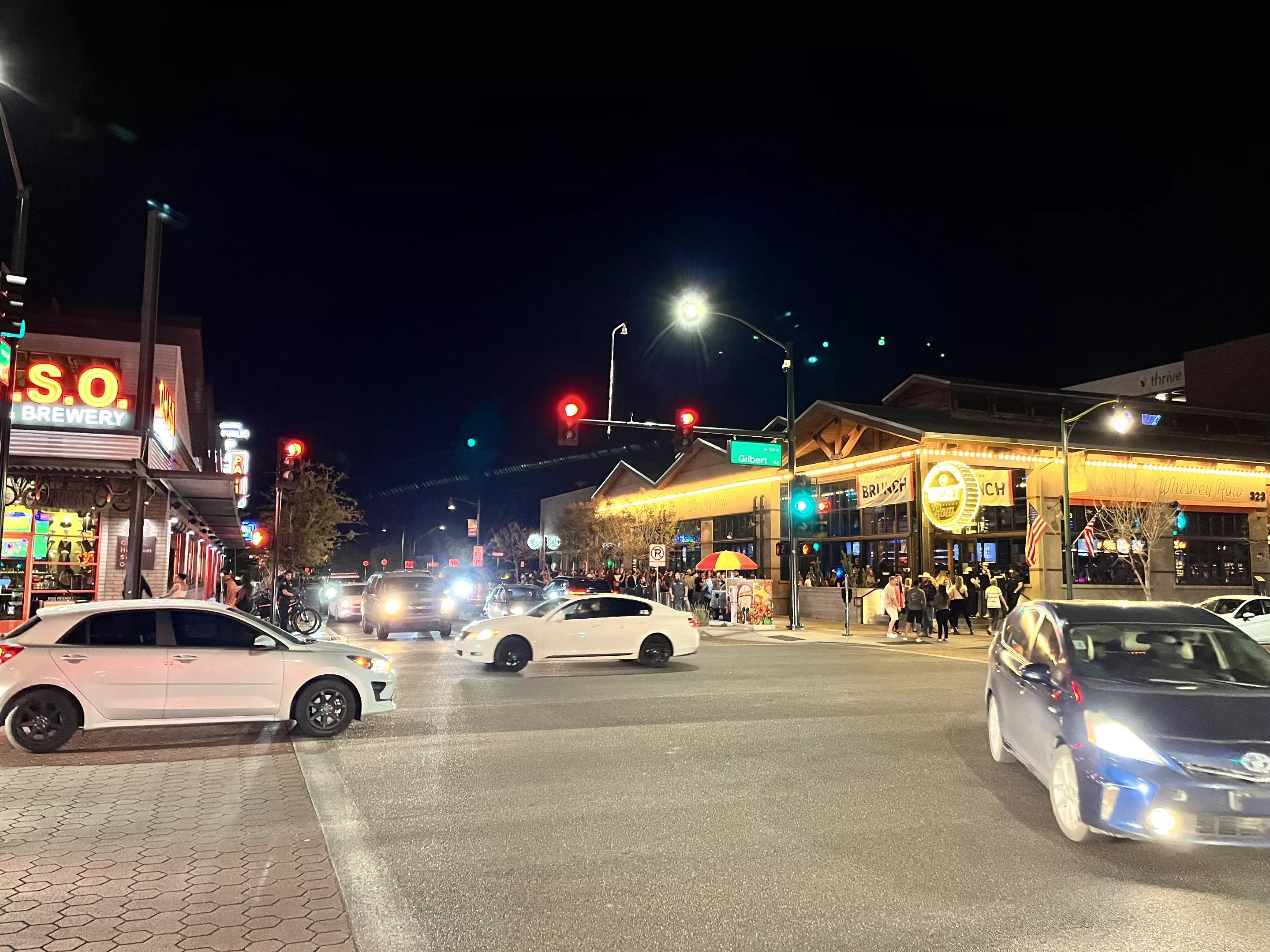
Officially known as the Heritage District, downtown Gilbert has developed into a hopping restaurant and bar hub on the weekends.
Georgann Yara
Sticking to the plan
The way the Heritage District was created also distinguishes it from Tempe and Scottsdale’s party districts. The seed was planted in 1989 when downtown Gilbert was designated as a redevelopment area. The designation includes a redevelopment plan that, by statute, must be updated every 10 years. Since 1991, it has gone through four updates with the most recent in 2018.
In conjunction with this plan, the town purchased property to address slum and blight. Today, more than 50 percent of non-residential downtown land is owned by the town, according to Gilbert economic development director Dan Henderson.
Efforts to attract investors have shaped the area into an economic driver. Through this strategy, Gilbert moved into the culinary tourism realm which attracted restaurants and then bars, even though the latter may not have been intentional.
“A commitment to not creating a bar scene, but a truly nighttime economy paved the way,” Henderson says. “There was a relentless pursuit to create a place where people can be comfortable.”
This meant making it very walkable with ample crosswalks, aesthetically appealing structural details and public art.
A redevelopment commission composed of volunteers advises the town council and ensures the plan is executed and stays true to what the community wants.
TJ Claassen, a Scottsdale real estate broker who lives about a mile northeast of the Heritage District where his wife owns the Dog Spaw, is the commission chair. A third-generation Phoenician who grew up in Arcadia, Claassen was an early skeptic.
“When I moved to Gilbert seven years ago, I found out how my assumptions were wrong,” he says.
Claassen’s job puts him in a position to lobby potential downtown business owners. The fact that Millennials and young professionals from Arcadia and Scottsdale who now live in the southeast Valley still crave the brands they grew up with should not be overlooked, he explains.
A few years ago, Claassen brought John Dolan, who owns the restaurant group responsible for The Porch, downtown to show him around. Dolan hadn’t been before and was impressed enough that he set up shop in 2021.
“He wanted to experience it first hand. It almost sells itself,” Claassen says. “It was an easy discussion. John said, ‘I know I need to be here.'”
The Heritage District’s customer base hails from a 30-minute drive radius and attracts 1.5 million visitors each year, Claassen says.
The town promotes happy restaurateurs’ testimonials to other business owners and joins other campaigns. That’s how a group of high school students used social media to lure Lolo’s Chicken and Waffles to downtown. All of this contributes to the momentum.
“We know you need to have a daytime and nighttime economy to be successful and that nighttime economy is so important to younger people,” says Amanda Elliott, Gilbert’s redevelopment program manager.
Creating the 2018 plan included seven years of public outreach to ensure community voices were adequately heard.
“When you experience rapid growth, there is some trepidation,” Elliot says.
The commitment to public safety was among the ways all sides came together to address concerns.
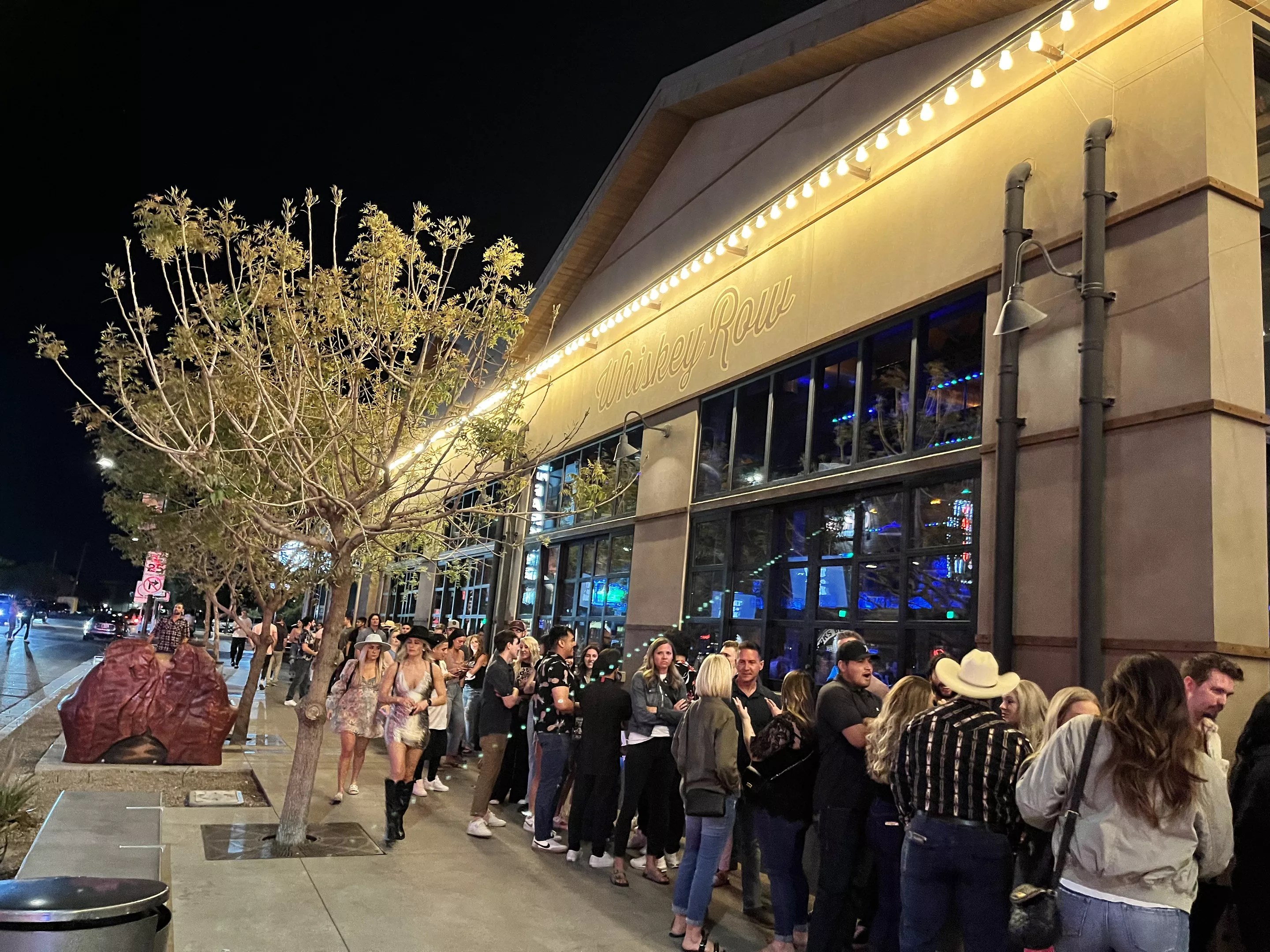
Long lines like this one outside of Dierks Bentley’s Whiskey Row are routine at the country bar.
Georgann Yara
Big neon energy
Downtown Gilbert owes much of its look and feel to the huge neon sign that Liberty Market’s former co-owner Mae Ong designed in 1959, which still hangs today.
Johnston grew up in the neon sign era and when he designed Joe’s Real BBQ, he wanted it to look as if it had been a barbecue restaurant since day one. He thought a neon sign like Liberty’s would do the trick. The town obliged.
“We designed the first animated neon sign that had been done in the Valley in a decade or two,” Johnston says of what has become an equally iconic downtown marker.
When Upward Projects brought in Postino and Joyride Taco House, Bailey encountered a rare level of government accommodation, she says. For example, they were met with fast turnaround with permits, encouragement of large patios, input on setbacks and ongoing conversations that revolved around what she and DeMarco needed rather than a list of restrictions.
This led to Joyride’s eye-catching neon sign that boldly begs for attention.
“No other city does this. That’s why it looks the way it does and feels the way it feels. The energy is right on the road,” Bailey says.
Downtown Gilbert’s transformation into a nighttime destination was a combination of government economic effort, restaurateurs willing to take a risk and a million-plus people excited to have something in their backyard. Or closer to it.
“There’s a huge population out here. We’re tired of driving to Scottsdale and Phoenix. So, to have a nexus where you can get that same sort of nightlife, it’s going to be a gathering point,” Johnston says.
At 10:35 p.m., it was far from last call. But it was past the posted 10 p.m. closing time at Clever Koi, which sits on the north end of the district.
The dining room at this Asian-inspired restaurant was nearly empty. But in the bar area, guests at high-top tables ordered a fresh round and two bartenders were still serving small plates and craft cocktails.
When a bartender asked a customer if she wanted a second drink, she declined, explaining she was ready to close out. The bartender responded, “Aw, but the party’s just getting started.”